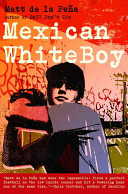
Sixteen-year-old Danny searches for his identity amidst the confusion of being half-Mexican and half-white while spending a summer with his cousin and new friends on the baseball fields and back alleys of San Diego County, California.
- ISBN: 9780385733106
- Author: Pena, Matt De Le
- Published: 2008 , Delacorte Pr
- Themes: Baseball, biracial, Identity
- Descriptors: Fiction, Intermediate (ages 9-14), Latinx in US, Realistic Fiction, Young Adult (ages 14-18)
- No. of pages: 249

Refreshing use of realistic teen language and characters with flaws. A fine example of sophisticated authorship that dignifies its audience with complex issues and depth.
Long after I set this book down, the characters Danny, Uno and Sophie stayed with me. The gritty realism of this story about belonging and transcending circumstances are anchored in so many unforgettable scenes in National City—some violent, some tragic, some hilarious. Danny’s natural pitching talent makes it a great sports read (ok, going back to his school to challenge the pro-bound player was a bit of a stretch, but I would’ve followed Danny and Uno anywhere in my imagination at that point!). The deeper issues about race and racism, poverty, and identity make it so much more than just a great book with sports action, though! For teachers interested in a social justice curriculum make sure to add this to your collection, you will get incredible mileage out of it.
When I learned about this for the first time, I was so intrigued by the title of it. Sixteen-year-old Danny is so conscious about his biracial identity. Often he finds he is not fitting-in with his father’s relatives or his mother and her new boyfriend. We may take too lightly what your skin color would do in our lives. It a is pretty significant fact for Danny in that he is half white and half Mexican.
His father is Mexican and his mother is white. His biracial look is almost like his father’s last and permanent trace on him because his father left when was little. Perhaps his dad’s absence in his life and the way he looks makes him insecure and even shy. The journey of Danny is powerfully written, reaffirming his identity. Although the story starts from the awkward position being biracial, his dilemma and insecurity take him to different relationships,like Uno, whose life is also complicating. Being different yet finding one’s agency is the hidden powerful theme of the book that invite us to think about moments of “not fitting in” and yet allows to find ways to be okay with it.
I LOVED this book, and so did a large population of my 9th/10th grade boys! What a great novel to hook young boy readers and allow for connections to not only literature but cultures. I too felt like I was reading a story about my boys at Gervais, and have already put it up on my “Mrs. Swan’s Must Reads” wall as a recommendation to my current students!
Although “coming of age” stories are a classic theme within young adult literature, Mexican White Boy tells the tale of 16-year-old Danny in a fresh, compelling way that draws the reader in almost immediately. Danny’s “voice” bonds the reader to him, as he struggles with his feelings of being forever an outsider–half Mexican in his suburban school life and half White and non-Spanish speaking in the summers he spends with his father’s Mexican family. The reader is privy to Danny’s voice at times when the characters of the novel are not, as he is often “voiceless” around others, insecure, uncertain, and struggling to find words that fit with his tumultuous emotions.
What Danny lacks in words, he makes up for in athletic skill, yet even his talent at baseball is something he cannot quite embrace or accept–again, he struggles as he vacillates between two worlds–the high pressure and high stakes (and intimidating players and coaches) of his prep school vs. the neighborhood “pick up” games with his cousins and their friends during the summer.
What struck me the most as I read this book was the author’s craft at creating a character that rang so true to me–as someone who taught adolescents for a dozen years, Danny’s inner voice connected with me deeply–I felt I knew him and had known him in countless other adolescent boys I taught over the years. The characterization and conflict in this book are compelling and the book is both dramatic coming of age story with tinges of mystery around the edges as Danny struggles to discover who and where his father really is and what that means about him and his own identity.
This title connects to WOW Books October 2011 theme of “Young Adults Straddling Cultural Divides,” illustrating how one character (like so many young adults I know and taught) finds his self identity to be messy, evolving, and often confusing. This book’s plot and themes also reaffirm to young people (and adults) that our identity, is not fixed but instead, is able to change and adapt with us as we grow in our knowledge of the world around us and of ourselves. I can see many young readers connecting to Danny and this novel in a myriad of ways.